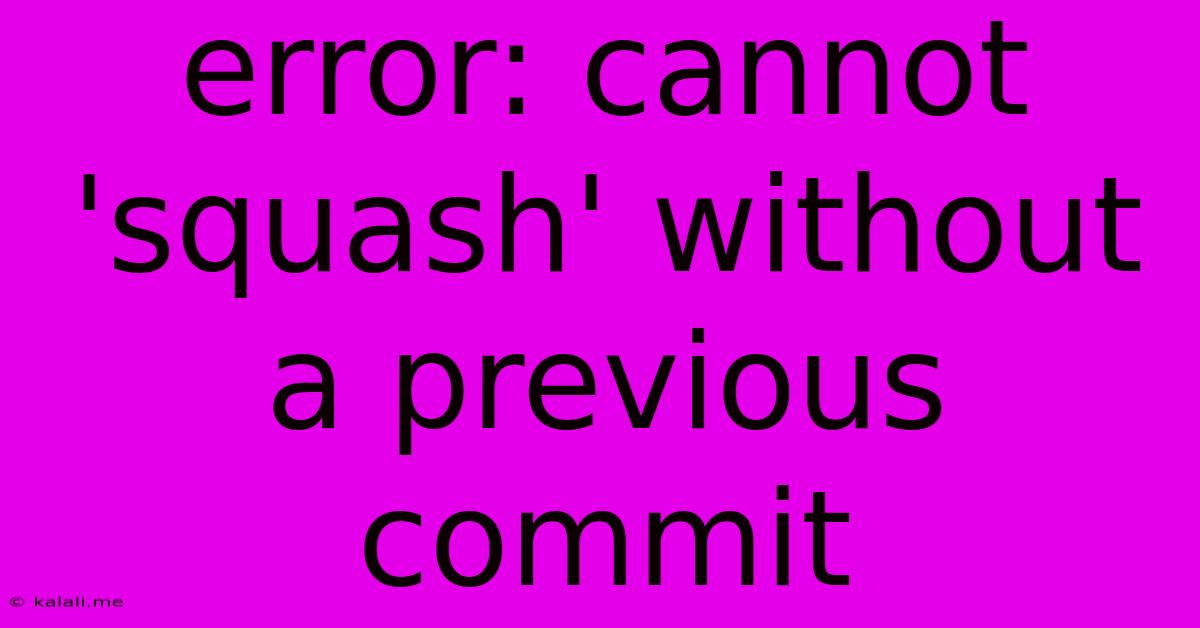Error: Cannot 'squash' Without A Previous Commit
Kalali
Jun 05, 2025 · 3 min read

Table of Contents
Error: Cannot 'Squash' Without a Previous Commit: A Git Troubleshooting Guide
This error, "error: cannot 'squash' without a previous commit," is a common frustration for Git users, especially those newer to the platform. It arises when you try to use the git rebase -i command (interactive rebase) to squash commits, but there aren't any commits to squash into. This guide will explain why this error occurs and provide clear solutions to get you back on track. Understanding this error will significantly improve your Git workflow.
What is Git Squashing?
Before diving into the solution, let's briefly understand what squashing commits means. Squashing combines multiple commits into a single, more concise commit. This is extremely helpful for cleaning up your commit history, making it easier to read and understand, particularly before merging a feature branch into the main branch. A clean commit history is vital for efficient collaboration and code review.
Why the Error Occurs: The Missing Commit Context
The error "cannot 'squash' without a previous commit" happens because the git rebase -i command needs at least two commits to work its magic. Squashing requires a target commit (the one you're squashing into) and one or more commits to be squashed into that target. If you only have a single commit in your branch, there's nothing to squash together. Think of it like trying to combine one single piece of Lego – there's nothing to combine it with.
Solutions to Resolve the Error
Here are the solutions to fix this common Git problem, catering to different scenarios:
1. You Have Uncommitted Changes:
-
This is the most common cause. Before attempting to squash, make sure you have staged and committed your changes. Use these commands:
git add . # Stage all changes git commit -m "Your commit message" # Commit your changesNow, try your
git rebase -icommand again.
2. You Have Only One Commit:
-
If you only have one commit, squashing isn't possible. You need to add more commits to your branch. Make changes to your code, stage them, and commit them.
# Make changes to your code git add . git commit -m "Your new commit message"After this, you can perform the interactive rebase.
3. You're in the Wrong Branch:
- Double-check that you're in the correct branch. Use
git branchto see your current branch and then switch to the branch where you want to squash commits usinggit checkout <branch_name>.
4. Force Push (Use with Caution!):
-
This should be a last resort. Avoid this method unless you completely understand its implications, as it can cause conflicts and problems for others collaborating on the same repository. Force pushing overwrites remote history.
git push --force-with-lease
Best Practices to Avoid This Error:
-
Commit Frequently: Commit your changes often with descriptive messages. This avoids large, monolithic commits that are harder to manage and squash. Think of commits as small, logical units of work.
-
Understand Git's Workflow: Familiarize yourself with the Git basics, including staging, committing, branching, and rebasing.
-
Use a GUI Tool (Optional): While command-line Git is powerful, GUI tools like Sourcetree, GitHub Desktop, or GitKraken can make visualising and managing commits easier, reducing the chances of encountering this error.
By following these solutions and best practices, you can avoid the "cannot 'squash' without a previous commit" error and maintain a clean, efficient Git history. Remember, understanding the fundamentals of Git is crucial for smooth version control.
Latest Posts
Latest Posts
-
Wire Size For A 60 Amp Breaker
Jun 07, 2025
-
Fridge Is Working But Freezer Is Not
Jun 07, 2025
-
Why Does The Bird Die In The Vanishing Cabinet
Jun 07, 2025
-
Can I Delete Alias On Mac
Jun 07, 2025
-
How To Remove A Bolt With A Stripped Head
Jun 07, 2025
Related Post
Thank you for visiting our website which covers about Error: Cannot 'squash' Without A Previous Commit . We hope the information provided has been useful to you. Feel free to contact us if you have any questions or need further assistance. See you next time and don't miss to bookmark.